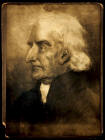 The iconic asylum known as the York Retreat was founded by Quaker philanthropist, William Tuke, in 1792. When it opened for patients four years later, its approach was considered a radical departure from contemporary asylum practice, especially in its minimal use of restraint, and its rejection of physical punishments.
The iconic asylum known as the York Retreat was founded by Quaker philanthropist, William Tuke, in 1792. When it opened for patients four years later, its approach was considered a radical departure from contemporary asylum practice, especially in its minimal use of restraint, and its rejection of physical punishments.
Innovative it may initially have been, but more than fifteen years elapsed between the installation, in 1861
at Cork, of the first Turkish bath in an asylum, and that at The Retreat.
|
Some asylums with Turkish baths |
|
Year |
Asylum (contemporary nomenclature) |
|
1861 |
Cork District Lunatic Asylum (Eglington Asylum) |
| 1861 |
Sussex County Lunatic Asylum, Hayward’s Heath |
| 1862 |
Limerick District Lunatic Asylum |
| 1865 |
Middlesex County Pauper Lunatic Asylum, Colney Hatch |
| 1871 |
North Wales County Lunatic Asylum, Denbigh |
| 1876 |
Metropolitan Asylum for Pauper Imbeciles, Leavesden |
| 1877 |
The Retreat, York |
| 1885 |
Holloway Sanatorium, Virginia Water |
| 1893 |
London County Asylum (Claybury Asylum) |
In July 1874, when John Kitching retired after twenty-five years as Superintendent, he wrote a paper for the Committee of Management suggesting eighteen improvements for their consideration; the fifteenth was that a Turkish bath would be ‘exceedingly useful’ in treating their patients.3

John Kitching, reproduced from a photograph in
Retreat unlisted collection (2005)
in the Borthwick Institute, University of York
Why did Kitching wait so long? He was a member of the Medico-Psychological Association26 in 1866, when its President-elect was
Charles Lockhart Robertson of Hayward’s Heath, its Council included Edgar Sheppard of Colney Hatch, and Thomas Power of Cork and George Turner Jones of
Denbigh were both fellow-members.4 It seems quite inconceivable that he was unaware of the successful Turkish baths in their asylums.
It is true that Power’s early report of successful ‘cures’ was greeted with cynicism by the British Medical Journal5 and damned with faint praise in The Lancet.6 And many doctors, already wary of quacks and suspicious of
hydropathy, sensibly queried the claims of some doctors who implied that the bath was a therapeutic panacea.
But it seems more likely that his tardiness merely confirms Anne Digby’s view that ‘After the mid-19th century the Retreat became rather a symbol of historical achievement than a current model in the world of asylumdom.’7
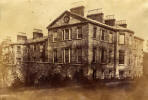
The Retreat in the 1870s
When Kitching did finally write his paper, he argued that the proposed Turkish bath would enable ‘the provision of a life in which monotony and ennui shall be reduced to a minimum form, as effectually parts of the treatment of the insane, as the taking of medicine.’3
On 17 November 1874, a sub-committee was set up to consider Kitching’s suggestions, and Dr Robert Baker, his successor, was already in post when its report was presented on 15 December.

Robert Baker, reproduced from a photograph in
Retreat unlisted collection (2005)
in the Borthwick Institute, University of York
The sub-committee recommended building a new single storey Gentlemen’s Lodge with seventeen bedrooms and seventeen sitting rooms adding: ‘the court at the end of these bedrooms would be the best situation for the erection of a Turkish bath, and rooms in which other
hydropathic treatment may be administered.’8
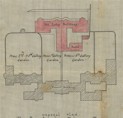
Location of the Gentlemen's Lodge and Turkish baths,
reproduced from
part of an original (RET 2/1/13/7)
in the Borthwick Institute, University of York
They further suggested that the new lodge, ‘and probably the erection of the rooms for the new Turkish bath, &c would be the first work to be undertaken, and that these should be completed before any other work is commenced.’
Finally, they suggested that Dr Baker should visit other institutions ‘to thoroughly inform himself respecting Turkish baths, Hydropathic and other improved modes of treatment’.
To all of this, the Committee of Management agreed, and at its meeting on 16 February 1875, Edward Taylor, the Retreat architect, was instructed to work with Baker in drawing up plans for the Turkish bath at a cost not to exceed £1,400, including equipment and furnishing.9

Builder's estimate of the cost of the new lodge and baths,
reproduced from an original (RET 2/2/7/4)
in the Borthwick Institute, University of York
Taylor’s plan, already completed, and with the committee by 27 May, benefited both from Baker’s visits to other institutions, and from experience gained generally in Turkish baths during the two decades since the first one was built at St Ann’s.
Within the newly built red brick and stone-faced building,10 the facilities were far superior to those at Hayward's Heath (which, in 1861, had cost just under £50)11 or
Colney Hatch (£300 in 1865).12 Neither of these baths had provision for any form of hydropathic treatment, nor even a complementary vapour bath. Indeed, provision at The Retreat was superior to that in several commercial establishments.
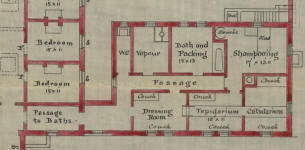
Detail from Taylor's plan of the new lodge and baths,
reproduced from an original (RET 2/1/13/7)
in the Borthwick Institute, University of York
Taylor’s plan provided two hot rooms.13 The design temperature of the
tepidarium was 120-130° Fahrenheit, and that of the calidarium 130-180°.14 Possibly due to expense, but more likely for safety reasons there was no laconicum. In a commercial establishment, the laconicum temperature was often greater than 200°.
The air was heated in the boiler room situated in a cellar beneath the shampooing room. The cellar had a direct fresh air intake from outside the building, while the hot air duct led straight into the calidarium, cooling as it passed into the tepidarium.13
The vapour bath was a
cabinet model constructed so the bather’s head remained cool outside.

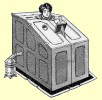

Enlarged images have extended captions
In 1889, Baker gave a paper on ten years’ use of the Turkish bath at The Retreat, the published version of which included a plan with only one significant change from Taylor’s original.14
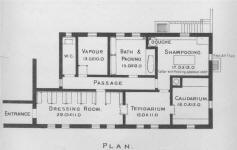
Plan of baths re-drawn by Taylor in 1889
The dressing room is now much larger, and is divided into cubicles, with couches enabling bathers to relax after their bath.
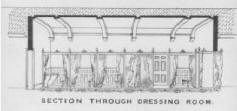
The cubicles in the dressing room
We don’t know whether the baths were originally built according to the first plan, or if they were altered later.
The former seems most likely because Baker’s investigative tour of other baths would surely have impressed upon him the need to provide some sort of cooling-room for the bath to be totally effective.
More surprising is that the later plan retains the Bath and Packing Room in which hydropathic treatments were to be provided. There were three hydropathic components of what was popularly known as the cold water cure: drinking considerable quantities of mineralized water; exposing the body to a variety of
specialized showers or douches; and wet sheet packing where the patient was wrapped in cold wet sheets for varying periods of time.
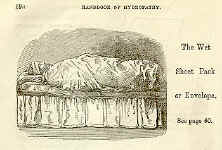
Wet sheet packing at Smedley's Hydro
To start with, patients felt decidedly cold, but gradually they became increasingly warm until they broke out in perspiration, rather akin to a fever. Dr Barter had concluded that it was the feverish perspiration (rather than the cold sheet) which was responsible for any improvement in the patient's condition, hence his wish to instal the—rather more comfortable—Turkish bath at St Ann's.
Although packing was popular in hydropathic establishments for several years, it is not mentioned in Baker’s paper, and this was almost certainly due to the fact that the Commissioners in Lunacy felt it necessary to include wet sheet packing among their deprecated forms of mechanical restraint.15
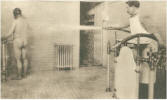
The hosepipe shower, or,
Le grande douche in use at Vichy Spa, France, late 1890s
And le grande douche would have been completely unacceptable to them because even at The Retreat, again according to Digby, the treatment books for 1853 show that hosepipe showers were frequently resorted to as a means of quieting patients, the water temperature and pressure being solely determined by whichever attendant administered them.16
Once the baths were built, running costs were relatively small. Baker put the heating cost at between nine and eleven shillings per week,17 and part of this was met by opening the baths to the public,18 a practice already well-established at the Newcastle-upon-Tyne Infirmary, and later followed by
Huddersfield Royal Infirmary.
It appears that originally it was intended to open the baths to men only, but with its external entrance there was no logical reason to exclude women.

Proposed opening hours and charges for the new Turkish baths,
reproduced from
an original (RET 5/7/7/2)
in the Borthwick Institute, University of York
It is difficult to discover how many non-patients used the baths as records are incompletely available. But it is known that the practice continued until at least 1908.2
One of the first non-patients was so impressed that he wrote to the
York Herald:
. . . Since the establishment of the hot air bath at the Friends Retreat, I have bathed there twice or thrice every week, and can therefore bear willing testimony as to its comfort and efficiency as well as to the ability of the attendant, who has had as much or more experience than any other man in England. I am informed that a thoroughly efficient bath could be erected in connection with the proposed corporation baths (fittings included) for the sum of from £500 to £700…19
However, his wish to see the corporation adopt this suggestion was not fulfilled—the corporation apparently unwilling to become involved.
Baker’s 1889 paper is a thoughtful, carefully considered, document. Bearing in mind the limits of contemporary medical knowledge, his claims on behalf of the bath are understated.
He separates usage into two categories: the bath as a curative agent, and the bath as a palliative agent.
Benefits of the Turkish
bath
(contemporary nomenclature) |
|
Curative |
Palliative |
|
Alcoholic insanity |
Epileptic insanity |
| Gouty diathesis |
General paralysis |
| Liver congestion |
Chronic insanity |
| Puerperal mania |
|
In the first category, the curative use of the bath, he includes
its use with alcoholics, writing,
I do not wish to undervalue the use of drugs in the treatment of the various forms of alcoholic insanity, but I have been so pleased with the power of charming away the condition of irritability and suspicion, so generally seen in these cases, by the frequent use of the Turkish bath that I would wish very decidedly to commend it to your notice.20
He suggests that this was also applicable to those who abused morphia, chloral and other narcotics.
In this category he also includes successes in middle-aged sufferers from gout, and melancholia accompanied by a ‘dry skin’ or a ‘disordered and congested condition of the liver’.
Baker, feet firmly on the ground, continues:
Far be it from me to imply that the use of the Turkish bath will invariably cure these cases. All I wish to say is that in some cases I have thought it to be a useful adjunct to the use of other remedies.21
And in the case of ‘puerperal insanity’—what we should call extreme post-natal depression—he maintains only that the bath will tend to speed the cure of those who would, in any event, recover.
As a palliative, Baker first approves its effect with epileptics, reporting ‘the chorus of unanimous indignant complaint’22 received if, on occasion, the bath was out of use.
Second, for what Baker refers to as cases of general paralysis of the insane—the now rare syndrome at that time occurring in tertiary syphilis—he notes ‘the soothing and calming influence of the careful use of the Turkish bath’, remarking how such patients ‘enjoy the luxurious sense of ease that a bath affords, and they are gratified at being for a couple of hours the sole recipients of the close personal attention of their bath attendant.’23
And third, in the treatment of the chronic insane, the bath was something to look forward to in a world of monotony, besides being the most efficient means of effecting patients’ personal cleanliness.
Baker also draws attention to the situation in asylums where members of staff, who have lived with the anxieties and pressures of working with the mentally ill for many years, have themselves then shown signs of mental stress. He writes:
I have seen several instances during the past seventeen years, but since our attendants and nurses have been allowed the free use of the Turkish bath only one such case has come under my notice.24
As is so often the case, much publicity surrounds the launch of a project; it is far harder to tell when it ends, and all we know at present is that the baths were still in operation in 1908.
Whatever modern medicine may teach us, it is difficult to disagree with Baker’s concluding thoughts:
...first, I believe that the Turkish bath will probably assist you in promoting the recovery of some of your patients; and, second, that I know, and am sure, that by its judicious use you may infuse additional happiness, solace, and brightness into the lives of some of those whom we know to be amongst the most sorely-tried of the members of the family of “suffering, sad humanity”.25
This descriptive account of the Turkish baths at The Retreat merely sets the scene; it clearly points to the need for further research to determine whether there is any evidence, perhaps in patient records, to indicate whether the use of the Turkish bath was considered successful in any specific instances.
Last revised 26 August 2011
















